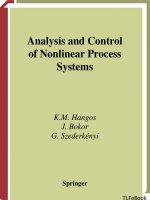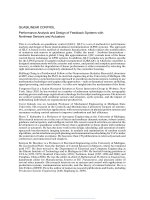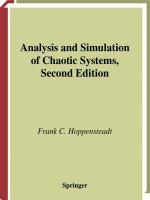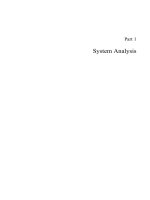Analysis and Control of Linear Systems - Chapter 10 doc
Bạn đang xem bản rút gọn của tài liệu. Xem và tải ngay bản đầy đủ của tài liệu tại đây (597 KB, 44 trang )
Chapter 10
Synthesis of Closed Loop Control Systems
10.1. Role of correctors: precision-stability dilemma
The correction methods covered in this chapter refer to considerations of scalar
behavior. It is fundamental to understand that the specifications stipulating the
closed loop performances will be translated by the constraints on the frequency
response of the open loop corrected system.
The search for a compromise between stability and rapidity generally leads to
imposing, on the closed loop, a behavior similar to that of a second order system
having conjugated complex number poles. The choice of the damping value
ξ
is
imposed by the required degree of stability. That is why it is indispensable to have a
good knowledge of the relations between the parameters and the behavior of the
second order systems in order to be able to use specifications defining the
performances required from the closed loop final system. The general principle of a
specification list is based on two points:
– interpretation of specifications in order to obtain the characteristics of a second
order model of the closed loop needed;
– search for the constraints on the open loop introducing the behavior sought in
closed loop.
For reasons of clarity, let us recall the main results of the previous chapter
concerning the analysis of the behavior of systems.
Chapter written by Houria SIGUERDIDJANE and Martial DEMERLÉ.
284 Analysis and Control of Linear Systems
10.1.1. Analysis of systems’ behavior
10.1.1.1. Static errors
For a zero static error:
– with respect to a set point step function, there has to be at least one integration
in the open loop;
– with respect to a set point ramp, there have to be at least two integrations in the
open loop;
– with respect to an interference step function, there has to be one integration
upstream from the input point of the interference in the open loop.
10.1.1.2. Stability
The analysis of stability of the looped system, in the current case of a stable
system in open loop, is based on the simplified Nyquist theorem: the image of the
contour by
µ
β
must not surround the point –1. The distance with respect to point
–1, which is expressed in terms of phase margin and gain margin provides a
“measurement” of stability.
We can associate a “visual” criterion of the stability measurement with the help
of the closed loop response overflow with a set point step function. For a system
whose closed loop transfer function is of second order, we know how to connect the
concept of unit-step response overflow to the damping coefficient ξ of the poles and
consequently to the phase margin of the open loop (OL). We note that for a second
order system, a sufficient phase margin implies a good gain margin and the only
concept of phase margin is thus sufficient.
Figure 10.1. Overflow curve based on damping
Synthesis of Closed Loop Control Systems 285
Another way to characterize a stability measurement consists of analyzing the
frequency response of the closed loop. The instability is characterized by the
presence of a resonance peak.
For a system whose closed loop transfer function is of second order, we connect
this concept of frequency response resonance of the closed loop to the damping
coefficient
ξ
of the poles and hence to the phase margin of the open loop.
ξ
∆Φ in degrees
Resonance in dB
0.1 12 12
0.2 22 8
0.4 43 2.7
0.6 58 0.35
Table 10.1. Damping, phase and resonance margin
There is no more resonance from .7.0=
ξ
10.1.1.3. Rapidity
The character of rapidity can be perceived in two ways, either directly by
observing a time or frequency response, or indirectly through the concept of
dynamic error (a rapid system enables the pursuit of an input that rapidly varies and
hence a low dynamic error; see the method of the equivalent sine curve described in
the previous chapter).
Closed loop frequency behavior, bandwidth
To evaluate the rapidity of the looped system, a sinusoidal input is used whose
frequency can be chosen. More often than not, the transfer function of feedback
β
is a constant and we can then consider two cases for the behavior in closed loop
µβ+
µ
1
.
If
1
µβ
>> , i.e. if we are in the bandwidth in open loop, we can consider the
closed loop behavior equivalent to
β
/1 , presenting a constant gain irrespective of
286 Analysis and Control of Linear Systems
the frequency. For any frequency sinusoidal input in the bandwidth, we can then
consider that the output is a faithful image of the input.
If
1
µβ
<< , i.e. we are outside the bandwidth in open loop, we can consider the
behavior in closed loop equivalent to
µ
. In this case, the amplitude of the output is
very low compared to the amplitude of the input.
A simple evaluation of rapidity consists of considering the bandwidth
c
ω
in
closed loop. With a constant feedback
β
, we can then consider the closed loop gain
as constant if
1>>
µβ
. Hence, we can associate the bandwidth in closed loop with
the bandwidth in open loop. The bandwidth in open loop is a qualifier of the rapidity
in closed loop.
Time behavior in unit-step response
We can also qualify the rapidity of a closed loop system by observing its
response to a set point step function. For a system without overflow, we can measure
the establishing time, but the dilemma precision-stability often leads to a
compromise that entails a response with overflow. For a system having such a
response, we use as a rapidity criterion the time necessary to reach the first
maximum noted by
m
t .
For a second order system we can connect the time notion of first maximum to
the concept of bandwidth in open loop
2
1/
ξωπ
−=
cm
t . We can use in general
the relation approached:
3≈
mc
t
ω
which is valid for any correct damping
()
.16.0 <<
ξ
Due to this relation, we can translate a first maximum time constraint of a unit-
step response in closed loop into a bandwidth constraint in open loop.
Dynamic precision
In order to calculate an upper bound of the instantaneous error following the
variations of any set point, we use the method of the equivalent sine curve. The
result of this analysis leads to a specification of minimum gain in open loop for a
certain bandwidth 0 to
0
ω
. Therefore, this constraint leads in general to imposing a
certain bandwidth to the open loop, even if the constraint in the gain refers only to
the bandwidth 0 to
0
ω
.
Synthesis of Closed Loop Control Systems 287
In short, we will use the following rules:
– in order to obtain a good precision, we need to:
- in static state, have one or more integrations in direct chain in order to cancel
the permanent state errors,
- in dynamic state, have a high gain for a frequency band until
0
ω
. This makes
it possible to limit the dynamic errors;
– for a good degree of stability, it is necessary that the phase margins and (or) the
gain margins defined near
c
ω
are satisfactory;
– for good rapidity, it is necessary that the bandwidth in open loop is large and
therefore generally having a high gain.
If we use the Bode diagram to represent the scalar characteristics of the open
loop to be corrected, we could translate the above constraints depending on three
frequency areas as indicated in Figure 10.2.
The previous chart underlines the contradictions between the specifications
concerning precision and stability. An increase in the gain favors the precision at the
expense of stability.
Figure 10.2. Bode diagram of an open loop to be corrected
The correctors or regulators have the goal to provide a control signal u to the
process in order to maintain the requirements of precision and stability. They are
inserted into a looped system as represented in Figure 10.3.
288 Analysis and Control of Linear Systems
Figure 10.3. Corrector in a looped system
The control magnitude can be a function of bx,,
ε
or
e
. Based on the signals
considered and the type of the function created, there are several types of correctors.
Firstly, we will review the topologies of the most widely used correctors.
10.1.2. Serial correction
Figure 10.4. Serial corrector
This type of corrector is inserted in the direct chain in a serial connection with
the process and provides a control signal:
))(()( tftu
ε
=
The control takes into account only the error signal.
Among the usable functions f, we can find:
– the proportional action noted by P:
)()( tktu
ε
= or
)()( pkpU
ε
=
Synthesis of Closed Loop Control Systems 289
– the integral action noted by I:
εθ
=
∫
0
1
() ( )
t
i
ut dt
T
or
pT
p
pU
i
)(
)(
ε
=
– the derived action noted by D:
dt
td
Ttu
d
)(
)(
ε
=
or
)()( ppTpU
d
ε
=
– the phase lead action:
)(
1
1
)( p
aTp
Tp
KpU
ε
+
+
=
with 1<a
– the phase delay action:
)(
1
1
)( p
aTp
Tp
KpU
ε
+
+
=
with 1>a
A serial corrector creates the combinations of these actions more or less
perfectly.
It should be noted that this corrector acts on the static precision, dynamic
precision and stability.
For a first approximation:
– action I cancels the static error;
– action P increases the dynamic precision;
– action D or the phase lead tend to stabilize the system.
10.1.3. Parallel correction
This type of corrector is grafted in parallel on an element of the direct chain as
shown in Figure 10.5.
290 Analysis and Control of Linear Systems
Figure 10.5. Parallel corrector
1
µ
can possibly be a serial corrector. x is an intermediary magnitude between
the control and the output. If v contains a term of the form
dt
tds )(
, we say that we
realized a tachymetric correction.
It should be noted that this corrector acts essentially on the dynamic stability and
precision and not on the static error (this corrector cannot introduce integration).
10.1.4. Correction by anticipation
These correction techniques are used only as a complement of looped correction
techniques. They rely on the injection of signals in open loop in order to minimize
the transitions felt by the main correction loop, following the input variation or an
external interference.
10.1.4.1. Compensation of interferences (zero input)
Figure 10.6. Corrector by anticipation
Synthesis of Closed Loop Control Systems 291
Let us suppose that the interference is measurable. It is then possible – at least
theoretically – to eliminate the influence of the interference b(t) with the help of a
corrector by anticipation C(p) described by the diagram in Figure 10.6.
In fact, it is enough to choose:
2
1
()
()
Cp
p
µ
=−
to cancel the effect of
)(tb on the output.
We note in this case that the stability is not affected, nor is the precision with
respect to the input.
Most often,
)(
1
2
p
µ
is not physically feasible, which leads to adopting
approximate forms of
)(
1
2
p
µ
. There is no perfect compensation of the transient
state of interferences.
EXAMPLE 10.1.– if
p
K
p
=)(
2
µ
, we could take
()
p
p
K
pC
τ
+
−=
1
1
)(
with
τ
less
than the main time constants of
3
µ
.
10.1.4.2. Compensation of the input (zero interference)
Figure 10.7. Input compensation
This diagram can be considered, with respect to the error, as the overlapping of
the two diagrams of Figure 10.8.
292 Analysis and Control of Linear Systems
Figure 10.8. Diagram decomposition of the input compensation
We have:
()
βµµ
βµ
βµµ
εεε
21
2
21
21
1
)()(
1
)(
+
−
+
+
=+=
pCpE
pE
In order to cancel the error with respect to the input, it is enough to choose
βµ
2
1
)( =
pC .
It should be noted that in this case the closed loop control system perfectly
follows the input law, without introducing the integration in the direct chain. The
stability of the system is not modified, nor is the influence of interferences with
respect to the error. Most often,
βµ
2
1
is not physically feasible. Thus, the
compensation will not be perfect in transient states.
10.1.5. Conclusions
The feedforward correctors, when they are feasible, do not modify the stability
of the loop and compensate either the error due to the input, or the effect of
interference. In a complex case (several interferences, some of which are non-
Synthesis of Closed Loop Control Systems 293
measurable), the implementation of these compensators can be difficult and
imperfect.
The “parallel” correctors generally modify an element of the direct chain,
without introducing integration. They can be used in order to improve the stability.
The “serial” correctors modify the stability and precision with respect to the
input and interferences. This mode of correction is the most widely used.
10.2. Serial correction
10.2.1. Correction by phase lead
10.2.1.1. Transfer function
Generally speaking, we call a phase lead corrector a corrector whose transfer
function has the form:
aTp
Tp
KpC
+
+
=
1
1
)(
with 1<a
This corrector can be physically created by the circuit of Figure 10.9.
Figure 10.9. Phase lead network
with CRT
1
= and
21
2
RR
R
a
+
=
.
294 Analysis and Control of Linear Systems
It should be noted that the resistive bridge alone brings about an attenuation to
the low angular frequencies, which justifies the presence of an amplifier of gain
a
K
.
The Bode graph is represented in Figure 10.10.
Figure 10.10. Bode graph of a phase lead network
The tabulated values of the maximum phase input
m
φ
(obtained for
aT/1=
ω
) are given for your information (Table 10.2), in practice we can use the
formula
a
a
m
+
−
=
1
1
sin
φ
in order to find the value of a corresponding to a desired
m
φ
value.
a 1/4 1/6 1/8 1/10 1/12
m
φ
37° 45° 51° 55° 58°
Table 10.2. Maximal phase lead
Synthesis of Closed Loop Control Systems 295
10.2.1.2. Action mechanism of a phase lead corrector
There is no general method to configure such a corrector.
EXAMPLE 10.2.
Let us examine on a current case the problems linked to this configuration (see
Figure 10.11).
Figure 10.11. Uncorrected system
The OL of the uncorrected system presents an integration. An integral action is
hence useless in order to ensure a zero static error for a step function input.
Let us suppose that we want a response time
r
t imposed in closed loop, or a
dynamic precision given to an angular frequency
τ
ω
1
0
<< .
Thus, we have to introduce a minimum gain K (proportional action) in the chain
that leads to an insufficient phase margin:
)1( pp
KK
v
τ
µβ
+
=
with
K
such as
m
jp
v
G
pp
KK
=
+
=
0
)1(
ω
τ
,
or
m
v
G
KK
≈
0
ω
if
τ
ω
1
0
<< .
m
G is minimum gain required at the angular frequency
0
ω
.
We notice on the graph in Figure 10.12 that the phase margin becomes
insufficient. A correction is thus necessary, for example, a phase lead correction.
296 Analysis and Control of Linear Systems
Figure 10.12. Bode graph with insufficient phase margin
Figure 10.13. Bode graph in OL of the corrected system
Synthesis of Closed Loop Control Systems 297
Since this corrector is in series with
µβ
, there is an addition of gain and phase
curves in the Bode plane (Figures 10.10 and 10.12).
NOTE 10.1.– it should be noted that the open loop system without correction does
not shift phases beyond –180°. Consequently, a phase lead corrector chosen for
a = 1/6 – if it is conveniently placed – can bring a 45° phase lead, which is sufficient
to ensure a convenient stability degree for the system.
For that, we cut the axis 0 dB at the angular frequency
'1/
c
Ta
ω
= where the
phase lead of the corrector is maximal (environment in Bode representation of the
segment
[]
aTT /1,/1 ). Parameter a being chosen as well as the relative position of
'
c
ω
, we verify if the value of minimum gain requested is satisfied and if not we fail
the position of
'
c
ω
.
The resulting phase margin is calculated by adding the residual phase of the
uncorrected system to
c
ω
with respect to –180° and the
m
φ
of the corrector. It
should be noted in this example that the resulting phase with respect to –180° is
always positive. The looped system will thus always be stable.
EXAMPLE 10.3.– it is not always like this, in particular when the OL transfer
function of the uncorrected system shifts phases more than – 180°.
Let the OL system before correction be:
)1)(1(
21
ppp
K
ττ
++
with
21
τ
τ
> .
Figure 10.14. OL system before correction
298 Analysis and Control of Linear Systems
The phase margin of the corrected system is obtained by adding to the
m
φ
of the
corrector 180° plus the phase of the initial system to
'
c
ω
:
D
180)(
''
++=∆
mc
φωφφ
We note that this last term can be negative; hence we will need to choose a more
efficient corrector (smaller a).
When the phase curve of the system before correction decreases too fast, the
phase lead caused by the corrector risks being considerably contrasted at point
'
c
ω
.
The correction by phase lead can thus prove to be insufficient.
Figure 10.15. Correction by phase lead
In conclusion, the phase lead corrector:
– increases the bandwidth (
cc
ωω
>
'
);
– brings in
'
c
ω
a phase lead
m
φ
defined by
a
a
m
+
−
=
1
1
sin
φ
, if the corrector is
properly centered so that its central frequency coincides with the cutting frequency
of the corrected system. This choice of
'
c
ω
avoids the complete construction of the
phase in order to determine the phase margin obtained.
Synthesis of Closed Loop Control Systems 299
When the correction is perfectly set, in order to determine the final performances
of the closed loop corrected system, a complete construction of the module and
phase is necessary in the Bode plane. Therefore, a graph in Black-Nichols graph will
make it possible to obtain the closed loop transfer function.
10.2.2. Correction by phase delay
10.2.2.1. Transfer function
Generally speaking, we call phase delay corrector a corrector whose transfer
function has the form:
aTp
Tp
KpC
+
+
=
1
1
)(
with 1>a
This corrector can be physically created by the circuit represented in Figure
10.16.
Figure 10.16. Phase delay network
With CRT
2
= and
2
21
R
RR
a
+
=
.
The phase delay corrector has the Bode diagram represented in Figure 10.17.
300 Analysis and Control of Linear Systems
Figure 10.17. Bode diagram of a phase delay network
1/a 1/4 1/6 1/8 1/10 1/12
m
φ
–37° –45° –51° –55° –58°
Table 10.3. Maximal phase delay
10.2.2.2. Action mechanism of these correctors
The effect of these correctors is to increase the gain at low angular frequencies
and thus improve the static precision without modifying the behavior at high angular
frequencies.
In addition, we can use the phase delay corrector to make the gain fall at high
angular frequencies without modifying it at low angular frequencies.
With the help of an example, let us see the effect of this corrector.
21
τ>τ
Figure 10.18. Phase delay corrector
Synthesis of Closed Loop Control Systems 301
The desired performances are:
– zero static error;
– dynamic precision imposed at
τ
ω
1
0
<< ;
– stability degree imposed by a phase margin
φ
∆ from 45 to 50°.
The static error with respect to the input is zero (presence of one integration in
the direct chain) in the absence of interferences. The graph of the OL which makes
it possible to define the minimal proportional action K, ensuring the desired
precision is given in Figure 10.19.
A phase lead correction is impossible for such a system because the phase of the
OL decreases too fast near
ω
c
. Since the integral action is useless, we can then place
a phase delay corrector.
Figure 10.19. OL graph
This corrector must not affect the gain on the side of
0
ω
, hence the choice
0
1
ω
≈
aT
. The correction will be even more efficient for the stability as the gain
302 Analysis and Control of Linear Systems
curve will cut the axis 0 dB with the biggest slope segment possible (–1) and near its
environment.
Due to these considerations, we adopt as corrector
aTp
Tp
KpC
+
+
=
1
1
)(
with
aT/1 near
0
ω
. Parameter a will be determined by successive tests. The phase
margin after correction can be estimated as follows:
– calculate the ratio
T/
1
τ
characterizing the “length” of the slope segment (–1)
defined above;
– if the new gap angular frequency
'
c
ω
, chosen near the geometrical
environment of
[]
1
/1,/1
τ
T , is much higher than
0
ω
'
0
(10)
c
ωω
≥ and much lower
than
2
1
τ
,
⎟
⎟
⎠
⎞
⎜
⎜
⎝
⎛
≤
2
'
10
1
τ
ω
c
, then an approximation of the phase margin is given by
carrying over the ratio
T/
1
τ
in Table 10.2 for the phase lead corrector. After
correction, we obtain the Bode diagram in Figure 10.20.
Figure 10.20. Bode graph in OL of the corrected system
It should be noted that near the angular frequency
'
c
ω
, the contribution of the
two breaks, (–1) to (–2) in
0
ω
and (–2) to (–3) in
2
/1
τ
, is negligible. Everything
Synthesis of Closed Loop Control Systems 303
takes place as if only the slopes (–2), (–1) then (–2) remained with respect to the
phase. This graph is that of a double integrator in a serial connection with a phase
lead corrector.
It should be noted that the phase delay correction happened in this particular
example because the ratio between
2
/1
τ
and
0
ω
was high, but this is not always
the case (see the combined action correction).
The phase delay corrector decreases the bandwidth (
cc
ωω
<
'
) and the constant
stability static error (phase delay for non-integrator systems).
There again, once the correction is set, it is necessary to build with precision the
total OL in order to deduce the performances in CL.
10.3. Correction by combined actions
10.3.1. Transfer function
Generally speaking, we call a lead-delay combined action corrector a corrector
whose transfer function has the form:
()()
()()
pTpT
pTpT
KpC
41
32
11
11
)(
++
++
=
with
4321
TTTT >>>
This corrector is obtained by serially connecting a phase delay corrector
()
()
pT
pT
K
1
2
1
1
1
+
+
and a phase lead corrector
()
()
pT
pT
K
4
3
2
1
1
+
+
with KKK =
21
.
The Bode diagram of such a corrector is represented in Figure 10.21.
304 Analysis and Control of Linear Systems
Figure 10.21. Bode diagram of a lead-delay network
10.3.1.1. Action mechanism of these correctors
These correctors combine the actions previously studied. They are used when the
simple action correctors do not lead to the performances desired.
EXAMPLE 10.4.
Figure 10.22. Combined action corrector
In Figure 10.22, we have
21
τ
τ
> and as desired performances:
– zero static error;
– dynamic precision imposed at
0
ω
(close to
1
1
τ
);
– phase margin
φ
∆ from 45 to 50°.
Synthesis of Closed Loop Control Systems 305
Figure 10.23. Phase delay correction
The phase delay correction is inefficient here (proximity of angular frequencies
0
ω
and
1
1
τ
) and therefore in order to obtain the desired stability, a phase lead term
must be added.
The corrected OL is represented in Figure 10.24.
306 Analysis and Control of Linear Systems
Figure 10.24. Bode graph in OL of the corrected system
We can estimate the phase margin of the corrected system, if
'
c
ω
is close to the
environment of slope segment (–1), by referring to Table 10.2 of the phase lead
circuit. This would be even more justified in the present case since
0
'
10
ωω
>
c
and
4
'
10/1 T
c
<
ω
.
10.4. Proportional derivative (PD) correction
10.4.1. Transfer function
A proportional and derivative action corrector has as transfer function:
)1()( pTKpC
d
+=
The derivative action is not physically feasible and it is approximated by a
transfer function of the form:
p
T
d
τ
+1
with
d
T<<
τ
.
Synthesis of Closed Loop Control Systems 307
The new corrector has then as transfer function:
⎟
⎟
⎠
⎞
⎜
⎜
⎝
⎛
+
+
≈
⎟
⎟
⎠
⎞
⎜
⎜
⎝
⎛
+
+=
p
pT
K
p
pT
KpC
dd
ττ
1
1
1
1)(
Therefore, the PD corrector has a transfer function which is equivalent to that of
a phase lead corrector. The same methods could be used in order to determine
d
TK,
and
τ
.
10.5. Proportional integral (PI) correction
10.5.1. Transfer function
A proportional and integral action corrector has as transfer function:
⎟
⎟
⎠
⎞
⎜
⎜
⎝
⎛
+
=
⎟
⎟
⎠
⎞
⎜
⎜
⎝
⎛
+=
pT
pT
K
pT
KpC
i
i
i
1
1
1)(
The proportional integral regulator (PI) has as its Bode diagram that in Figure
10.25.
Figure 10.25. Bode diagram of a PI corrector









